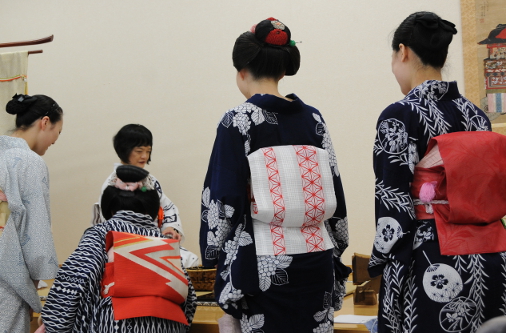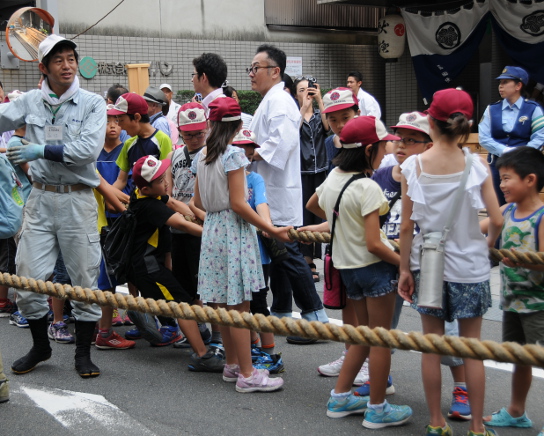It’s Gion Matsuri again! I haven’t been out to see any of the big events this year, I’m only writing about them… But, as a Kyoto resident, there is no excuse: You must go and see Gion Matsuri.
Today, me and two friends of mine got all dressed up in our summer yukata and went out to see the construction of the first set of floats for the Saki Matsuri Parade next Monday. We had tickets for a tea ceremony at the float called Kikuhoko, which is one of the big ones about 25 m high, with a big golden chrysanthemum on top. These things are done to raise money for the respective yamaboko community, together with selling souvenirs like chimaki and other charms or tenugui.
The tea ceremony was a very casual one. Only the master who made the tea was kneeling on a slightly raised platform, all the other guests were sitting on tables and there was a constant coming and going. Before the matcha we were served a sweet jelly made from black sugar on a blue plate shaped like a chrysanthemum (which we were allowed to keep, by the way). While we were sipping our tea, a group of young girls came in to sit in front of us. My friend gave me a nudge and said “honmono – the real thing”. Yes, during Gion Matsuri even lowly people like us have the chance to meet real maiko… After the tea ceremony, we went through the hokomachi to see some of the other yamaboko in construction. I always love to see the Funehoko which is shaped like a boat, so we went there among others. We even came across one of the trial pullings that were taking place today, of the Hokahoko if I’m correct. The fun thing about this is that everybody may step up and help pulling, even women and kids who are obviously not part of the big, real parade.
After the tea ceremony, we went through the hokomachi to see some of the other yamaboko in construction. I always love to see the Funehoko which is shaped like a boat, so we went there among others. We even came across one of the trial pullings that were taking place today, of the Hokahoko if I’m correct. The fun thing about this is that everybody may step up and help pulling, even women and kids who are obviously not part of the big, real parade.
 We did not see all of the floats though, since it was quite hot with 36 degrees. And even though people may tell you otherwise, a yukata is a quite warm piece of clothing… The last hoko we visited was the Naginata hoko. It is always the one to lead the parade and the only one left with a chigo, a young boy to perform a number of rituals during the festival month. We even went upstairs to the community house of the Naginata hoko, but women are not allowed to enter the float itself (all the others will be happy to grant everybody access, for a fee of course).
We did not see all of the floats though, since it was quite hot with 36 degrees. And even though people may tell you otherwise, a yukata is a quite warm piece of clothing… The last hoko we visited was the Naginata hoko. It is always the one to lead the parade and the only one left with a chigo, a young boy to perform a number of rituals during the festival month. We even went upstairs to the community house of the Naginata hoko, but women are not allowed to enter the float itself (all the others will be happy to grant everybody access, for a fee of course).
 I had a wonderful afternoon, and this year my yukata held up better than last year. I learned a few tricks on how to wear one better (involving towels), but I know that there is still room for improvement. I got several nice comments about my outfit in general, so I must have done something right. Bonus cute story: In the bus home I sat next to an old lady who all of a sudden leaned over and asked: “I’m sorry, it’s very rude, but… did you put on your yukata all by yourself?” And when I said yes I did and confessed that it took me 30 minutes, she was quite impressed about my dedication to do this!
I had a wonderful afternoon, and this year my yukata held up better than last year. I learned a few tricks on how to wear one better (involving towels), but I know that there is still room for improvement. I got several nice comments about my outfit in general, so I must have done something right. Bonus cute story: In the bus home I sat next to an old lady who all of a sudden leaned over and asked: “I’m sorry, it’s very rude, but… did you put on your yukata all by yourself?” And when I said yes I did and confessed that it took me 30 minutes, she was quite impressed about my dedication to do this!
